We may get commissions for purchases made through links in this post.
Sago palms or Cycas revoluta are becoming a popular epitome of tropical landscape. Their emerald and light green fronds make them stand out in the garden.
However, they may look tough but they are not an exception when it comes to sago palms diseases. As with other trees, sago palms can also be the target of spores that can cause them to die.
In this post, we will share the different sago palm diseases and some tips to prevent them. We also included the pests and other problems that you may encounter in growing sago palms.
Different Sago Palms Diseases And Treatments
Healthy sago palms have a strong resistance to drought, pest damage, and fungal diseases.
However, when they lack the essential nutrients and are planted in an unfavorable environment for their needs, their plan health can decline become a magnet for several fungal diseases which include:
Sooty Mold
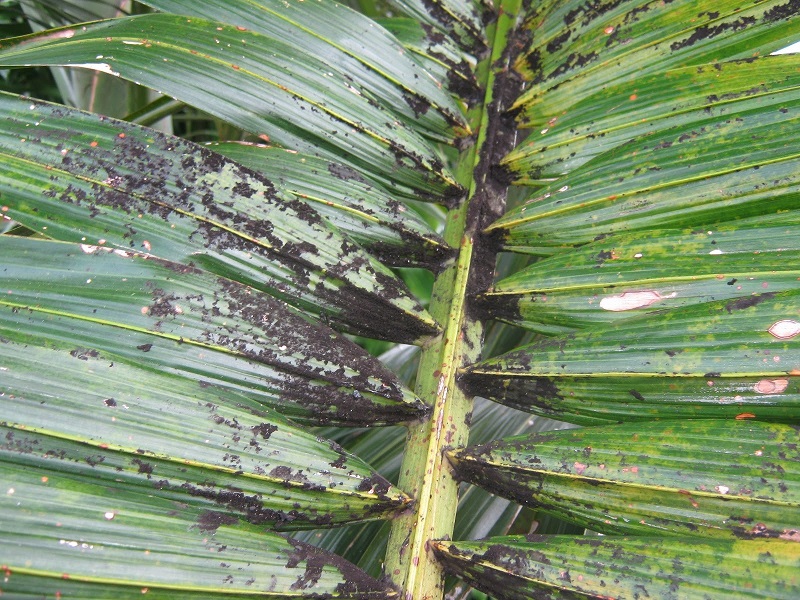
If you notice a formation of black powdery substance on the leaves of your sago palms, they may be due to sooty mold. It is caused by the fungi that colonize on the sap or honeydew left by sap-sucking insects on the leaves.
Sooty mold is not attached to the leaves, however, it can block the sunlight that will affect the photosynthesis of sago palms. Plus, the black soot can look unsightly on your sago palms.
How to get rid of sooty mold
To address the sooty mold, you must first get rid of the sap-sucking insects that cause the honeydew to spread onto the leaves.
The common sap-sucking insects that feed on the leaves of sago palms are as follows:
- Aphids
- Scales
- Whiteflies
- Mealybug
Since most sap-sucking insects that feed on sago palm leaves are soft-bodied insects, you can get rid of them by blasting them with water, handpicking them using a dish soap solution, or using insecticidal soap. The best insecticidal soaps to try are as follows:
- Garden Safe Brand Insecticidal Soap Insect Killer, Ready-to-Use
- Bonide Products Ready-to-Use Insect Soap
- Natria Insecticidal Soap Organic Miticide
As a secondary infection that happens on sago palm trees after a pest infestation, sooty rot can be resolved after you address the sap-sucking insects.
To remove the mold from the leaves, you can place it outdoors during summer and let the rain and sun wash the mold off naturally. You can also wipe the mold off with soapy water.
Here’s how to make one at home:
Materials:
- 1 tablespoon of dish soap
- 1 gallon of water
Directions:
- Mix the tablespoon of dish soap into a gallon of water.
- Transfer the dish soap solution to a spray container or a bucket with a cloth.
- Use accordingly.
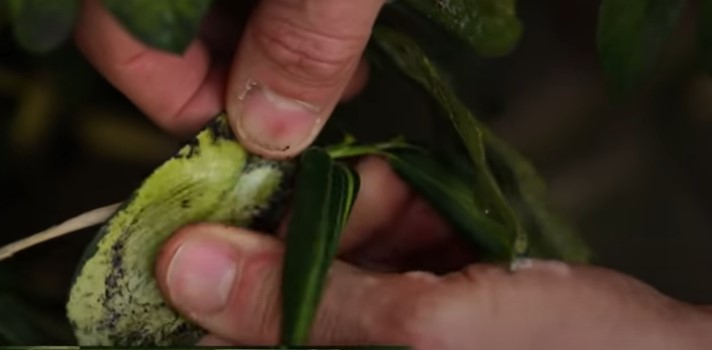
Root Rot
It is common in sago palm trees that are planted in wet soil with poor drainage.
Sago palms are tropical trees and are more drought-resistant than other varieties of palm trees. If you water them too much, the roots will not get the essential nutrients from the soil and fungi will develop on the roots.
Root rot can be due to two possible reasons: overwatering and lack of oxygen. Roots need oxygen to thrive and develop. If the soil is too compact, the roots will die and start decaying underneath and even spread decay to other healthy roots.
Root rot that is due to overwatering is caused by the fungus Phytophthora that thrives in a wet environment. The development of fungi can starve your sago palms to the nutrients from the soil causing yellow fronds and wilted leaves.
Other signs of root rot include:
- Sap oozing out of the trunk
- Droopy and deformed fronds
- Overall wilting of the sago palm
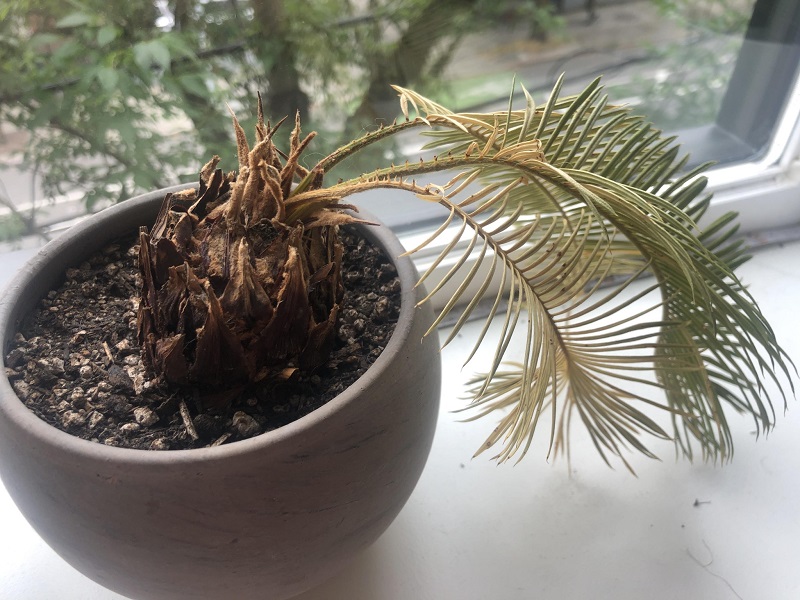
To prevent and treat root rot, you must check the soil drainage of your sago palms. Some gardeners tend to forget to check the holes at the bottom of the pots, leaving the roots of sago palms and soil drenched in water.
Root rot can kill your sago palms, so the earlier you treat them, the higher chances of their survival.
It is crucial to remove the infected parts and treat them with a fungicide to help them recover from the disease. To get rid of the fungus, you can dip the bare roots into the diluted fungicide solution.
Here are some of the best fungicides for treating root rot in palm-type trees:
Crown Rot
Aside from the roots, fungi can also attack the crown of sago palms. Like root rot, crown rot also causes the base of the fronds to produce a brownish-black sticky sap. Its distinct attack often starts with the youngest and newly formed leaves.
Because of this fungal disease, new leaves and fronds may fail to develop but the old fronds with unhealthy leaves will remain intact. Other signs of crown rot include:
- Black lesions appear on the fronds and trunk.
- Torn, wilted, and rotten fronds and leaves
- Dark lesions and cankers on the trunk
- Slow and stunted growth
If you have both sago palms and varieties of palm trees, preventing the spread of fungal infection is crucial since crown rot affects them both. The location of sago palms should also be in a partially shaded area and not in full shade to prevent the spores of fungal diseases from getting to the crowns of sago palms and other varieties of palm trees.
Other ways to prevent the spread and treat crown rot are as follows:
- Avoid overhead watering the sago palm trees to prevent building a moist environment for the fungus spores.
- Get rid of the weeds around the sago palms to prevent insects that carry spores get into the sago palm.
- Use a fungicide to treat sago palm such as Mefenoxam 2AQ Fungicide.
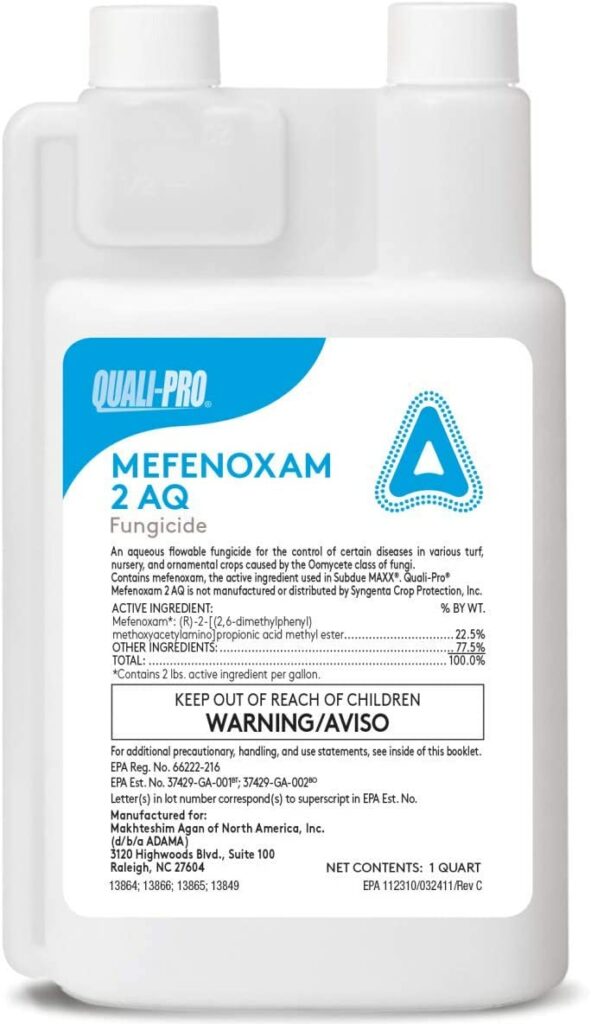
Pro Tip: Younger sago palm trees have a higher chance of surviving a crown rot than matured trees.
Pink Rot or Gliocladium Blight
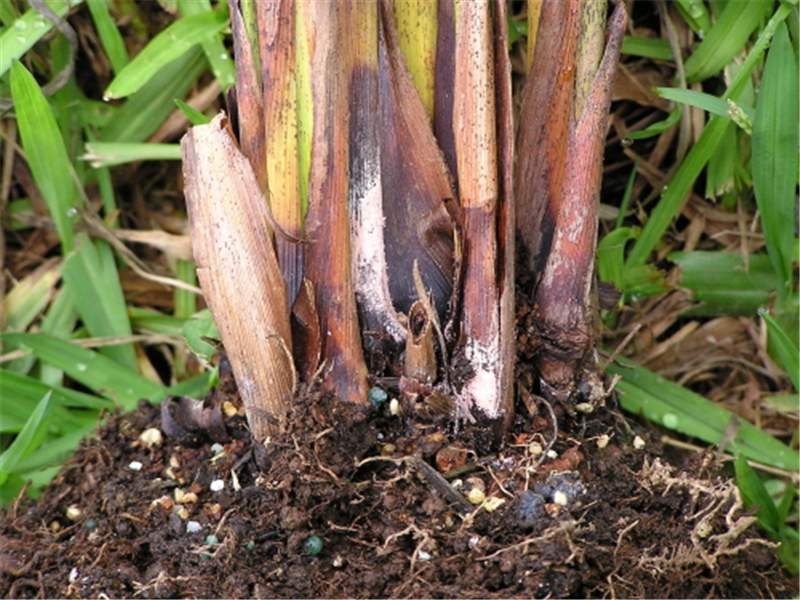
Pink rot or opportunistic fungus is a fungal disease known for its pink spore that may manifest throughout the sago palm.
It targets weak sago palms that are affected by pes damage, poor growing conditions, and soil drainage, and other diseases. Wounding the sago palm through cold damage or accidental gardening maintenance can also cause pink rot.
Prevent pink rot by keeping your sago palms healthy. Plant them in a location with an adequate climate. Sago palm trees are not a fan of cold temperatures and can cause them to suffer freezing wounds.
Like other fungal diseases, pink rot is better prevented than treated. However, you may get a better chance of reviving your sago palms if you caught the pink rot early.
The best strategy to treat pink rot is to place the sago palm and change the growing conditions that made it sick. You can also try to battle pink rot by using the following fungicides:
- Bonide Mancozeb Flowable with Zinc Fungicide Concentrate
- Clearys 3336 F Fungicide (Thiophanate-methyl)
- Southern Ag – Thiomyl
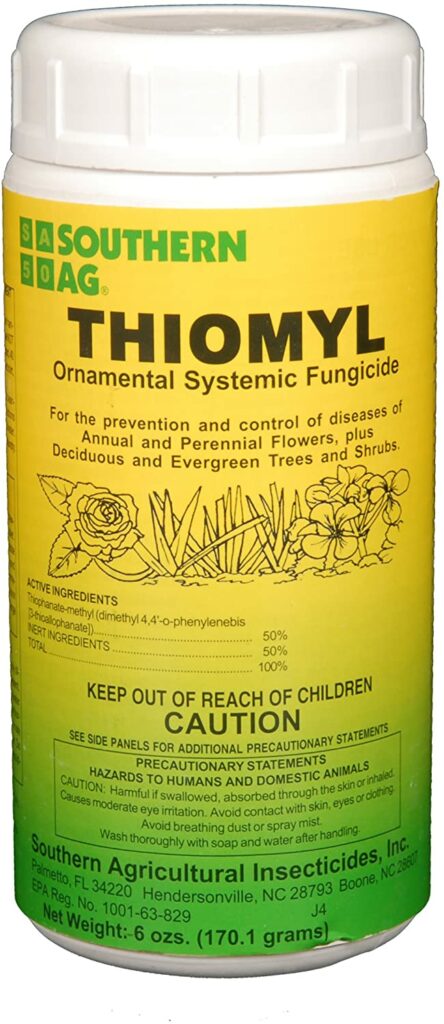
Ganoderma Butt Rot
The worst-case among sago palms diseases is the Ganoderma butt rot. It affects the trunk of sago palms that causes the overall decline of plant health manifesting as wilting leaves. This fungal disease is caused by Ganoderma Zonatum.
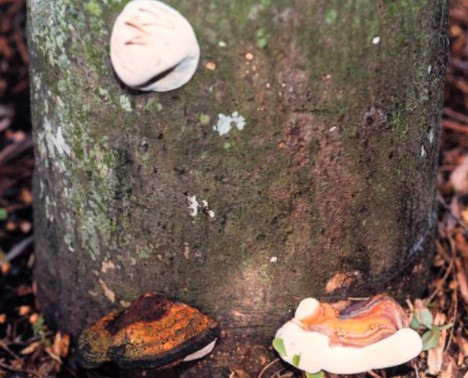
The telltale sign that your sago palms are dealing with Ganoderma palm rot is the growth of basidiocarp at the side of the trunk. When it matures it turns into a half-moon mass attached to the trunk. Its color changes from white to brownish-red and will later produce brown spores.
The fungus causes Ganoderma butt rot, which degrades part of the sago palm’s trunk. Symptoms also may include wilting or generally declining plant health.
Ganoderma butt rot is spread by spores. Once the sago palm is infected, there is no cure. Any infected plants should be removed as soon as possible, and no other sago palms or any palm trees planted in that same location.
Other Causes of Sago Palm Problems
The health decline of your sago palms is not always about fungal diseases. In most cases, sago palm diseases are only a secondary infection to an underlying problem. These include:
Pest Infestations
Palm-type plants like cycads or sago palms are prone to scales and mealworms. They are often the red and white spots that you see on the surface or the underside of the leaves.
Learn more about each insect and how to control them below:
Asian cycad scale (white scale)
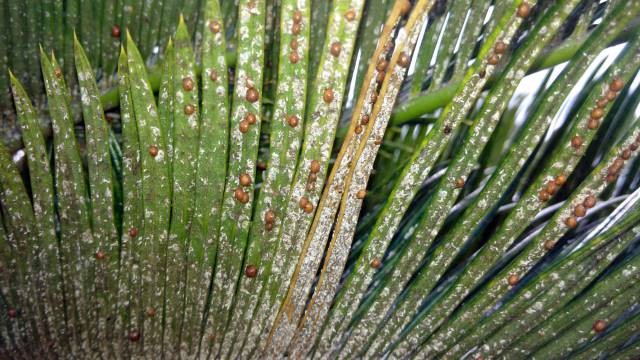
One of the most notorious pests that can kill sago palms due to severe infestation. The crawlers or the baby scales are the ones that start the infestation by feeding on the base of the leaves and the trunk. They will work their way to invade the surface of the leaves and their underside.
False oleander scales
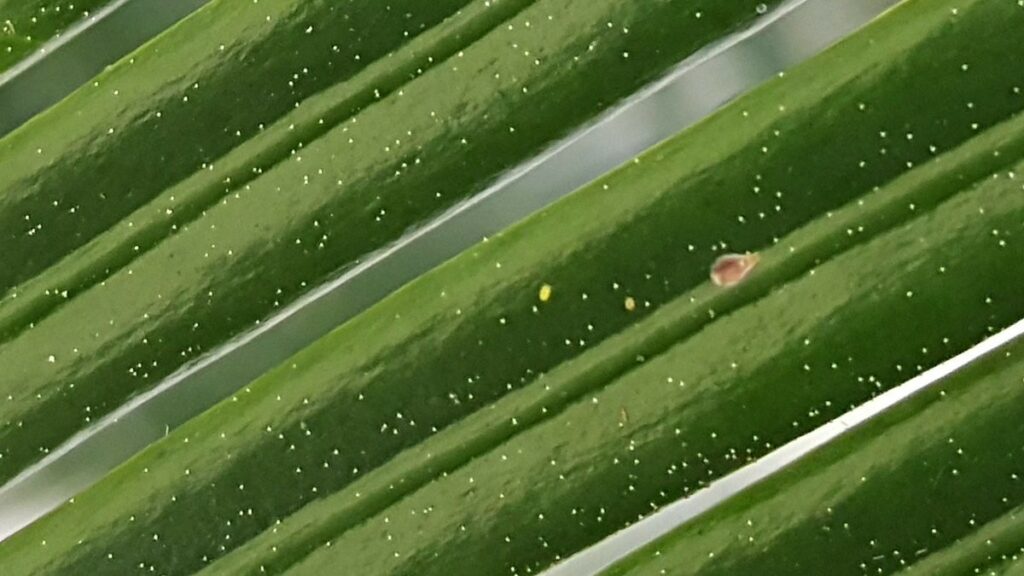
White insects look like white spots on sago palms. They never move once they have settled and fed on the surface of the leaves. They keep themselves attached to the leaves through their mouthpiece. They reproduce fast and can propagate a whole generation within a month.
Treatment For Scales
There are several ways to control scales and prevent them from propagating. These methods include:
(1) Handpicking: Nothing works better than the old way of removing visible insects by hand. Since most insects and their crawlers are quite microscopic, you can use a clean cloth and a dish soap solution to wipe off the insects.
One-time handpicking won’t be enough, so you’ll need a few times to wipe the scales off your cycads or sago palms.
(2) Blasting insects with water: Another environment-friendly method to get rid of the pesky insects on your sago palms is using water pressure. However, it may not be as effective if you are dealing with false oleander scales that grips onto the leaves using their mouthpieces.
Wetting the foliage can be a magnet for spores of fungal diseases. So, make sure to blast the leaves with water early in the morning to let the sun naturally dry the leaves.
(3) Let the ladybugs get their fill: Ladybugs are natural predators of scales. You can buy them online or breed them on your own and set them off the infected sago palm leaves.
(4) Horticultural oil, insecticidal soap, or systemic insecticide: Use the help of organic or synthetic insecticide to keep the scales of your sago palms.
Here are some of the best pesticides that you can try:
- Verdana USDA Organic Cold Pressed Neem Oil
- Safari 20SG Systemic Insecticide with Dinotefuran (for scales on the roots of sago palms)
- BIOADVANCED Insecticide Fungicide Miticide 3-in-1 Insect, Disease & Mite Control
(5) Cut off the heavily infested fronds: For severe infestations, cutting the whole frond is sometimes the wisest thing to do. Make sure to place the infested frond in a plastic bag and keep it away from your other plants.
Pro Tip: Dead scales will remain on your for several months. If you can scrape the scales off with your fingernails then those are already dead. If they are moist as you squish them, those scales are still alive. Dead scales are dry and powdery.
Recommended Post: Insecticidal Soap vs Neem Oil: Which Is Better?
Nutrient Deficiency
Another factor that encourages fungal growth in sago palms is nutrient deficiency. Your sago palms can become less resistant to pests and diseases due to their lack of certain vitamins and minerals.
A common nutrient deficiency in the family of cycads is manganese deficiency.
The lack of manganese in cycads usually manifests when the new fronds and leaves are yellow and frizzled or have splotches of yellow.
In some cases, the leaves and fruits also become smaller than usual. At some point, many gardeners often mistake yellow leaves at the lower level for manganese deficiency. However, if the lower leaves are turning yellow, it’s only the natural process of cycads.
Manganese deficiency on cycads is often due to high soil acidity or alkalinity. If the soil has incompatible acid levels to the PH level requirements of your plants, the roots will fail to absorb the nutrients from the soil. Even if you apply fertilizers that contain manganese, it will just leach out of the soil due to soil PH incompatibility.
The soil PH level for sago palms is between 5.5 and 6.5, so make sure that the soil is within that range. You can use a soil ph meter to avoid wasting all your efforts in adding fertilizers.
Once the soil pH of the soil is within the compatible range to your sago palms, you can use fertilizers that contain manganese sulfate as a treatment.
Pro Tip: Acidic soils are low in manganese. Check the soil PH first before planting or transplanting cycads.
Weather Changes And Environmental Problems
Tropical plants and trees like cycads may find it hard to adapt and be healthy in a cold and wet environment. They may also suffer from freeze damage such as wounds that can attract pests and other fungal diseases. Direct sun can also be too much for sago palms, causing the leaves and fronds to have burn damage.
Oftentimes, sago palm diseases are only a secondary condition to nutrient deficiency and damages. The worst thing about the spread of fungal diseases in cycads is not only their poor and unhealthy appearance but also the time wasted in growing them.
Sago palms are one of the ancient varieties of palms and they take about 8 years to reach maturity and become fully matured after 50 years.
Preventive care is the key to a healthy sago palm. Always check the soil PH level and be ahead of any pest and diseases by spraying neem oil and proper fertilization.
Final Thoughts
We hope that this post has helped you identify the sago palms diseases that you may encounter in growing cycads. They are easy to grow but, like other trees, they can also be threatened by fungus and pests.
If you find this post helpful and informative, please share it with your friends. Let us know in the comments how you and your cycads were able to survive the sago palm diseases that you experienced throughout your growing journey.
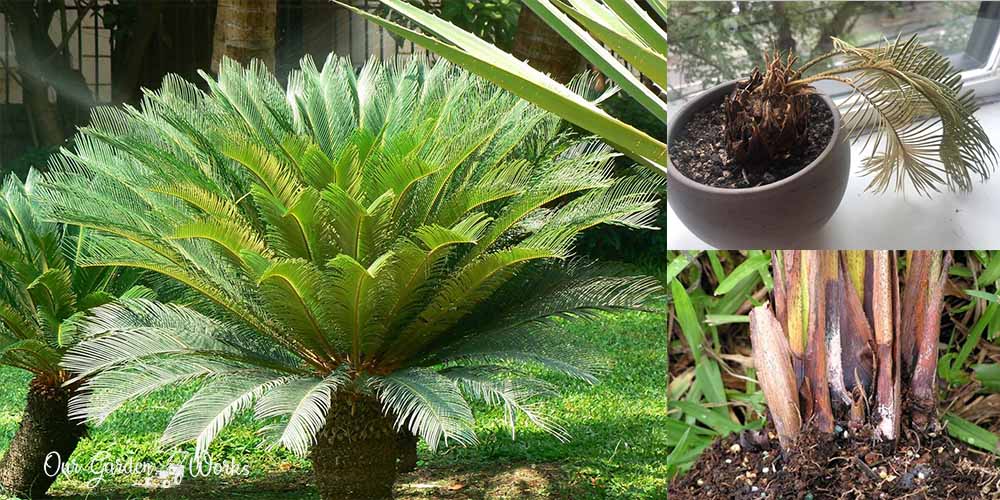
I cut the female pod off my Sago before it opened..the new ferns are barely sticking out where I cut the pod off? What can I do to encourage their growth?
Hi there! Your sago will do just fine. Give it some time to recuperate. Once the crow has dried out you will see the new fronds emerge from the center. You may also leave the seeds because they will be easier to remove as soon as they all dry up.
Hi Jeanne. I have a sago tree for about 5 yrs. now. This information is really helpful and informative. Thank you very much. I have the palm fertilizer. Is that one good for my sago go tree?
Thank you for reading our posts! Yes, you may use palm fertilizers for your sago palms. Usually, they need more nitrogen and potassium so check for fertilizers with an NPK ratio of 10-5-10 and the like. Some good fertilizer options are from Jobe’s Palm Tree Spikes. (From Jeanne)
Thank you for sharing your sago expertise. We have a 15 years old sago and 6 out of 10 has been showing signs of problems but couldn’t figure what it is. First the white stuff at the base of the leaves and some at the back of the leaves but I don’t know if it’s a scale or mealy bugs- leaves are turning brown then dries up. I have been treating it with horticultural oil but did not helped then last week I tried to spy at it with diluted 70% isopropyl alcohol but not helping. After a heavy rain last week, I noticed a clear gelatin like oozing out of the fronds. Can you please tell me what I should do to save my Sago Plants.
Hi Jewl Scott,
The white fuzz on your sago palm can be any of the three conditions:
– white fungus
– scruff
– cycad aulacaspis scale
If the horticultural oil is no longer working, then your sago palms might be dealing with a heavy infestation of white scale. With that, you may need to first remove the infected/infested parts. Then, spray a combination of a stronger pesticide using a mix of horticultural oil and malathion. Spray the solution once a week and see how it works for your cycads.
The clear gel-like gooey substance on sago palms or cycad is its natural healing processes. It covers the exposed part of the part to recover. It usually happens when you cut some fronds from the crown or a part of the crown got bruised. The substance is not something to be worried about. So, you’re all good on that part.
Hope this helps you save your sago palms.
Just read about your comment on white scale. My Sagos have it too. Can u tell me the measure of horticulture oil to malathion. I really need to try this for my infestation. Thank you. Milly Morgan. Georgia USA.
I have an small island that we created in our backyard over 10 years ago that have 3 large sago palms in it. Recently the palms have yellow fronds on a lot of the plants, but the rest of the plant is okay, and the new growth continues to emerge, some green, some yellow. We removed the yellowing leaves at the base and wondered what type of spray we can use on the rest of the palms.
Thank you.
Hello
My Sago is about 20 years old and the crown has ceased to develop.
The crown is about 12 to 16 inches across at it’s widest point but seemingly is unable to open exposing the new fronds. There is an apparent black tinge starting on the tips of the immature fronds. Also, I noticed that the old fronds have a brownish discoloration to them. The “Trunk” of the Sago is about 12 to 14 inches in diameter and stands about 5 foot tall. This plant Is located on my parkway strip and gets full sun, year round. Help! I hate to lose this plant.
Thank you for you time…………Thomas